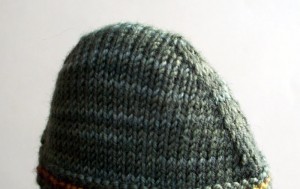This past week I’ve been on a sock-knitting kick. This is a good thing: with Sock Summit right around the corner, it’s high time to be in a sock-knitting mood. It all started with a stitch pattern that demanded to be in a sock worked from the toe up. (Sorry, can’t show details; it’s a stealth project.)
Toe #1 was a short-row toe in garter stitch, ’cause I thought the garter stitch would blend well with the rest of the design. Wrong. It was too busy; I needed a plain stockinette toe.
Toe #2 started with Judy’s Magic Cast-on, and proceeded in the usual wedge shape in stockinette. So far, so good: I like the toe. (Not too sure about the heel yet; more on that later.)
Now, my usual rant with sock toes—both cuff-down and toe-up—is that you get a nicer, more rounded toe, without any nasty “ears” or corners, if you vary the rate of shaping. For a wedge toe on a cuff-down sock, I’ll decrease four stitches every other round until half the stitches are gone, then I’ll decrease four stitches every round until the stitch count is cut in half again. In other words, the decrease rate doubles near the tip of the toe. On a toe-up sock, I start with a fast increase rate of four stitches every round, then switch to a slower increase rate of four stitches every other round.
Decreasing every round is easy enough, but increasing every round? It’s a bit of a booger. Lifted increases don’t cut it. And “make 1” increases are fiddly, when you knit your socks as tightly as I knit mine.
So in the past I’ve always resorted to twisted yarn overs: work a yarn over (or a backwards yarn over) on one row, then on the next row twist that yarn over by knitting it though whichever leg is furthest from the tip of the needle. Regular yarn overs twist left, and backwards yarn overs twist right. You end up with increases practically identical to M1L and M1R—as you can see in the photo above—without the fiddliness of picking up a tight little strand of yarn. You do, however, have to keep your wits about you, remembering on which rows to create yarn overs, on which rows to twist, and on which rows to do both. And writing the pattern instructions for such a toe? Not fun.
Which brings us to Toe #3. While skimming through a few resources in search of some heel insight, I spied some some “knit front and back” increases. They’re not my favorite. I mean, in garter stitch they blend in well enough. But I’ve never been keen on having their little bumps show in a stockinette fabric. Still, I had to ask myself: what if I got out some spare yarn, and tried knitting a wedge toe using kfb increases? How bad would it be?
Answer: not bad at all. The bumps line up neatly, forming a nice decorative element—assuming you notice them at all. They aren’t nearly as distracting as I thought they’d be. And they’re super-easy to do. The only catch—and it’s a minor one—is remembering to work kfb into the first stitch and into the next-to-last (not the last!) stitch on both the sole and the instep, so the bumps appear one stitch in from each side of the toe.
So it seems I have a new favorite toe-up toe. And Toe #4 of the week is going to feature kfb increases.
Comments are closed.




